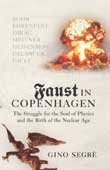The discovery of quantum mechanics 82 years ago led to one of the most profound revolutions in the history of human thought. This new theory changed the way we think about the sub-atomic world, about determinism and about the very nature of knowledge. It is perhaps surprising that, while the physicists who developed the theory were intensely serious, they also, as theoretical physicist Gino Segrè demonstrates in this lively and accessible history, spent huge amounts of time simply larking around. As Niels Bohr, the godfather of quantum mechanics, explained: “There are some things so serious you have to laugh at them.”
 When quantum mechanics first appeared, Bohr had just turned 40. He had won the Nobel Prize for physics, mainly for setting out the planetary model of the atom, and was a demi-god in his native Denmark. Although he wrote none of the theory’s seminal papers, he played a crucial role in its development by supporting the young theoreticians and by helping – through his torturous inquisitions – to clarify most of the new ideas. One of the beneficiaries was Werner Heisenberg, who later described Bohr as the 20th century’s most influential physicist, including Einstein.
When quantum mechanics first appeared, Bohr had just turned 40. He had won the Nobel Prize for physics, mainly for setting out the planetary model of the atom, and was a demi-god in his native Denmark. Although he wrote none of the theory’s seminal papers, he played a crucial role in its development by supporting the young theoreticians and by helping – through his torturous inquisitions – to clarify most of the new ideas. One of the beneficiaries was Werner Heisenberg, who later described Bohr as the 20th century’s most influential physicist, including Einstein.
At the annual gatherings at Bohr’s Copenhagen Institute, the young physicists organised entertainments, the most celebrated of which took place in April 1932. That year, the centenary of the death of Goethe, there was a performance of a tongue-in-cheek version of his great play Faust to highlight the knottiest problems of physics and gently parody the top quantum physicists. In Faust in Copenhagen Segrè makes this half-hour piece of amateur dramatics the centrepiece of the story.
There was certainly no shortage of characters to people this little drama. Quantum mechanics was developed by quite a gallery of eccentrics. One of the most striking is acerbic Austrian Wolfgang Pauli, who believed that “formal politeness must be eradicated from human relations.” He was rude to everyone, including his intellectually daring friend Werner Heisenberg – ruthlessly competitive even when playing ping-pong – and the English theoretician Paul Dirac, so taciturn that he spent days without speaking a word. Bohr, an inveterate mumbler, was a fatherly presence to many of his young colleagues and liked to use them as amanuenses (or “slaves”). In his quest for absolute clarity, he was assisted by the underrated Austrian physicist Paul Ehrenfest, an especially gifted teacher. Legend has it that soon after Ehrenfest met Pauli, Ehrenfest said to him, “I like your work more than I like you”, only for Pauli to shoot back, “With me, it’s the other way round.”
All of these characters feature in the Copenhagen Faust, largely written by Max Delbrück, later to be a Nobel-Prize-winning biologist. In Goethe’s original, the Satanic tempter Mephistopheles seduces Faust with the beguiling Gretchen. The main theme of the Copenhagen version is the story of Pauli’s quest to persuade the sceptical Ehrenfest of the existence of the neutrino, an electrically neutral particle that Pauli tentatively predicted in 1930. He was represented by Mephistopheles, Ehrenfest by Faust, and the neutrino by Gretchen, whose songs Heisenberg accompanied at the piano. The Lord was played by a character wearing a mask of the face of Niels Bohr, who shook with laughter when Mephistopheles intoned:
Since you, O Lord, yourself have now seen fit
To visit us and see how each behaves,
And since it seems you favour me a bit,
Well – now you see me here among the slaves.
The entire script, preserved and illustrated by George Gamow – the quantum community’s court jester – is replete with similar crimes against artistic taste. But the performance was not given to please drama critics but as an innocent, self-indulgent pleasure of the sort that insiders love and outsiders find embarrassing.
One of Segrè’s achievements here is to explain several of the in-jokes that shed light on the physicists’ preoccupations. Most popular science books make too little of theoreticians’ difficulties in distinguishing a productive new idea and a dud, but Faust in Copenhagen makes these challenges clear. It is fascinating to see some of the greatest scientists of the past century not only making sagacious insights but also misunderstanding things that are now routine for undergraduate physicists.
In April 1932, news had just been released of the discovery in Cambridge of the neutron, the electrically neutral particle contained in the nucleus of most atoms. Bohr and his colleagues knew this was important but they had no idea that two more crucial discoveries would follow later in the year: the splitting of the atom (also in Cambridge) and the first detection of anti-matter in California. For this reason, 1932 is often called the annus mirabilis of modern physics.
The glory days did not last. Bohr and his colleagues were subdued when they next met in September 1933. Most western economies were depressed, Hitler was Chancellor of Germany and catastrophic conflict was in the air. Five years later, on the eve of the War, nuclear fission was discovered in Berlin and physicists were quick to see that the process could be the basis of a bomb of unparalleled destructiveness. Many of the forty participants at the April 1932 Copenhagen meeting put their fundamental physics aside to seek ways of making the neutron a weapon of war. Physicists lost their innocence and have never quite regained it.
Graham Farmelo is Senior Research Fellow at the Science Museum. He has a PhD in theoretical particle physics and is currently completing a biography of the physicist Paul Dirac. Faust in Copenhagen is published by Jonathan Cape.

